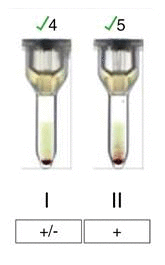Hemolytic disease in fetuses and newborns due to antibodies against the M-antigen
- PMID: 34936250
- PMCID: PMC8740393
- DOI: 10.7705/biomedica.5930
Hemolytic disease in fetuses and newborns due to antibodies against the M-antigen
Abstract
There are few case reports of hemolytic disease in fetuses and newborns (HDFN) caused by alloantibodies against the MNS blood group system. The reason for this dearth is that antibodies toward these antigens are usually IgM, which not only cannot cross the placental circulation but also react at temperatures below 37°C. They are, therefore, of minimal clinical importance. Nevertheless, cases have been reported in which the presence of anti-M IgG antibodies caused severe HDFN and even intrauterine death in the presence of maternal-fetal MNS incompatibility indicating that they could have a high clinical impact. The hemolytic pattern observed in these cases is similar to that caused by anti-Kell antibodies. Progressive anemia is mediated and developed through hematopoietic suppression inducing the destruction of bone marrow precursor cells with the resulting absence of reticulocytes in peripheral blood. This occurred in the case of a woman at 38.5 weeks of gestation who showed a discrepancy between direct and reverse blood type determination. A direct Coombs test was performed on the newborn’s blood, which was positive in the absence of maternal-fetal ABO incompatibility. Further tests were performed and anti-M antibodies were found in the maternal serum screening. Our final diagnosis was largely due to discrepancy issues in maternal blood. Although anti-M antibodies do not usually play a significant role in HDFN, this case stresses the importance of identifying the presence of antibodies that can be crucial in preventing HDFN and lead to new recommendations for the screening and prompt treatment of hemolysis in newborns.
Hay pocos reportes de enfermedad hemolítica del feto y del recién nacido causada por aloanticuerpos contra el sistema de antígenos MNS, especialmente, porque los anticuerpos que se generan contra estos antígenos son del tipo IgM, los cuales tienen reactividad a temperaturas inferiores a los 37 °C, y, por lo tanto, no son de importancia clínica. A pesar de ello, se han reportado casos con presencia de anticuerpos anti-M de tipo IgG causantes de la enfermedad hemolítica del recién nacido e, incluso, casos de muerte intrauterina por incompatibilidad materno-fetal en el sistema MNS. El proceso hemolítico se asemeja al causado por los anticuerpos anti-Kell, con anemia progresiva por supresión hematopoyética que induce la destrucción de precursores hematopoyéticos en la médula ósea y ausencia de reticulocitos en la periferia. Se reporta el caso de una mujer con 38,5 semanas de gestación, que presentó discrepancia en la hemoclasificación directa y en la inversa. Como resultado, el recién nacido fue positivo en la prueba de Coombs directa sin que existiera incompatibilidad ABO con la madre. La correlación de estos resultados llevó a la detección de un anticuerpo anti-M en el suero materno. El diagnóstico definitivo fue posible gracias a la discrepancia en la hemoclasificación de la sangre materna. A pesar de que los anticuerpos anti-M usualmente no desempeñan un papel importante en la enfermedad hemolítica perinatal, este caso resalta la importancia de determinar la presencia de diferentes anticuerpos que pueden ser de interés a la hora de prevenir resultados graves asociados con dicha condición.
Keywords: Erythroblastosis; fetal; blood group incompatibility; Coombs test; jaundice; neonatal; hyperbilirubinemia; blood group antigens.
Conflict of interest statement
Figures






References
-
- Gandhi MJ, Strong DM, Whitaker BI, Petrisli E. A brief overview of clinical significance of blood group antibodies. Immunohematology. 2019;34:4–6. - PubMed
-
- Wolff E, Jonsson B. Studien uber die untergruppen A1 and A2 mitesonderer berucksichtigung der paternitatsuntersuchungen. Dtsch Ztschr Gerichtl Med. 1933;22:65–85.
MeSH terms
Substances
LinkOut - more resources
Full Text Sources
Medical

